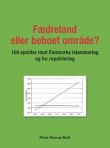I know the ethnic fertility is perhaps not accounted for in your country, but sooner or later it will be much easier to tell the truth. It is also easier not to have to take especially good care every single time you report the subject in a special neutral formulation: “Women in Germany” “Frauen in Grossbritannien“

According to: www.globalenvision.org/library/8/874
The Czech Republic, Germany, Greece, Italy, Poland, the Russian Federation, Spain and Ukraine have fertility levels now closer to one child per woman. Here the fertility level refers to the ethnic fertility.
Tabel 1: Total fertility and calculated
ethnic fertility in some European countries
|
Country/source |
Eurostat/2004 Total fertility |
Calculated 1) Ethnic fertility |
|
Spain |
1,26 |
1,04 |
|
Spain ”off.” earlier |
1,14 |
|
|
France |
1,90 |
|
|
Denmark |
1,78 |
1,21 |
|
Sweden |
1,75 |
|
|
Germany |
1,36 |
1,07 |
|
Holland |
1,73 |
|
|
Belgium |
1,64 |
|
|
Luxembourg |
1,71 |
|
|
Austria |
1,42 |
|
|
Italy |
1,33 |
0,95 |
|
Greece |
1,29 |
0,99 |
|
Portugal |
1,47 |
|
|
Great Britain |
1,74 |
|
|
Finland |
1,80 |
|
|
25 EU-countries |
1,49 |
|
|
15 old EU-countries |
1,46 |
1,08 |
Source to total fertility:
Eurostat: http://epp.eurostat.cec.eu.int/cache/ITY_OFFPUB/KS-AF-05-001/EN/KS-AF-05-001-EN.PDF page 16
1) Calculation of ethnic fertility in some European countries:
When we add the number of immigrants from areas outside Western Europe, North America, Israel, Japan, Australia and New Zealand included the naturalized and their children to the official accounted number of in this category 1 January 2006, we get a smaller number than reality, because the naturalized earlier than 1979 and their descendants are not included in the account from www.dst.dk , Databanken.
Even though the calculated number is more than the doubled of the official number in Denmark: http://www.lilliput-information.com/economics/uscan.html
The reasons to include the naturalized and descendants:
When we look at different events in community it seems as if the so-called integration-activities do not make much impacts. The public authorities in Denmark have admitted recently:
Second and third generation of immigrants or the descendants commit an even much greater share of the crime acts according to their respectively shares of the population (this account is even partly affected by the false official population account that ironically leads to an overestimatimated criminality of the immgrants and their descendants).
Second and third generation have an even weaker connection to the labour market than their parents.
Second and third generation gave birth to 10 p.c. more children a woman i Copenhagen over a five year period than their parents.
In average all immigrants from less developed countries load the public sector three times as much compared with the Danes (according to the newly report from the Danish welfare Commission), and the second and third generation load the public sector even heavier.
The number of immigrants from the selected area is the only number that has been growing – even accelerating and also exponential growing in periods – for all the last 25 year.
Long before the public authorities admitted this, it had been shown from almost every angel, including unemployment, public consumption, criminality and from an indirect correction of the official Danish demographic account. The last mentioned official account is being critized right now by researchers at the Danish Universities too.
We know from official population accounts that the foreign immigrants have percentage in fertile ages of 10-15 p.c. larger than the Danish percentage in the this ages group (15-40 years).
If we assume that 18 p.c of the birth given women in Europe are foreign immigrants, and that the foreigners give birth to 3(-3,5) child a woman in average, the total fertility can be calculated by a weighed average in this way:
0,18*3 + 0,85*FEeu = 1,46 that implies FEeu = 1,08, where FEeu is the average fertility in the 15 old EU-countries.
In Denmark the foreigners amount to 25 p.c. of birth giving women and the composition of the immigrants lead to an average fertility among foreigners of at least 3,5 child. The same in Italy:
0,25*3,5 + 0,75*FEda = 1,78 that implies FEda = 1,21
0,15*3,5 + 0,85*FEit = 1,33 that implies FEit = 0,95
Our future – of interest: http://www.lilliput-information.com/economics/engeufolk.html
The consideration of even an increase of the immigration to Europe has been evaluated in: http://www.lilliput-information.com/economics/euarb.html
The German women gave birth to just 680,000 in 2995, perhaps corrected to 578,000 when interpret the formulation correctly according to this reading. The real number of births among Germans should have been about the double in secure a stable German population, perhaps 1,056,000 corresponding to a fertility of 2.14 instead the present 1.07 child a woman.
To increase the immigration in order to compensate for this lacking amount of births leads automatically to Germans will become a minority twice as fast, and the increased immigration even increases the expenditures for several years in the sector which expenditures already have to be reduced substantial in order make the businesses remain in Germany. When we hear them say they want to stimulate qualified immigrants to come to Europe this time, we have vainly asked from where they do intend to get those qualified immigrants.
The same forces operate in the leading circles around whole Europe. If they want to get rid of the ethnic Europeans as quickly as possible, it should not be a secret.






























[…] https://danmark.wordpress.com/2006/05/19/12/ […]
Pingback af Europe does certainly not need immigrants « Danmark — 23. oktober 2006 @ 20:19
[…] Why not report the real birthrates of Europe: https://danmark.wordpress.com/2006/05/19/12/ […]
Pingback af Europe does not need immigrants « Dissidentpress — 23. oktober 2006 @ 20:31
[…] View […]
Pingback af All Posts on http://Danmark.Wordpress.com « Danmark — 18. marts 2009 @ 00:01
[…] 10. https://danmark.wordpress.com/2006/05/19/12/ […]
Pingback af Women in Austria: Persistent low fertility since 1980s « Dissidentpress — 18. april 2009 @ 21:16